Leadership and Management: Concepts, Theories, and M&S Analysis
VerifiedAdded on 2020/12/18
|18
|4843
|398
Report
AI Summary
This report delves into the fundamental concepts of leadership and management, differentiating between the two and highlighting their interconnectedness. It examines various leadership theories, including trait theory, behavioral theory, contingency theory, charismatic leadership, and transactional leadership, providing a comprehensive overview of their principles and applications. The report further analyzes a management development program at Marks and Spencer (M&S), exploring its structure and methods. The analysis covers the evolution of M&S, its organizational structure, and its approach to employee motivation and development. The report also explores the practical implications of leadership theories and management practices within a real-world business context, offering insights into how organizations can foster effective leadership and management to achieve their strategic objectives and enhance employee performance. The report concludes by emphasizing the importance of both leadership and management in driving organizational success and sustainability.
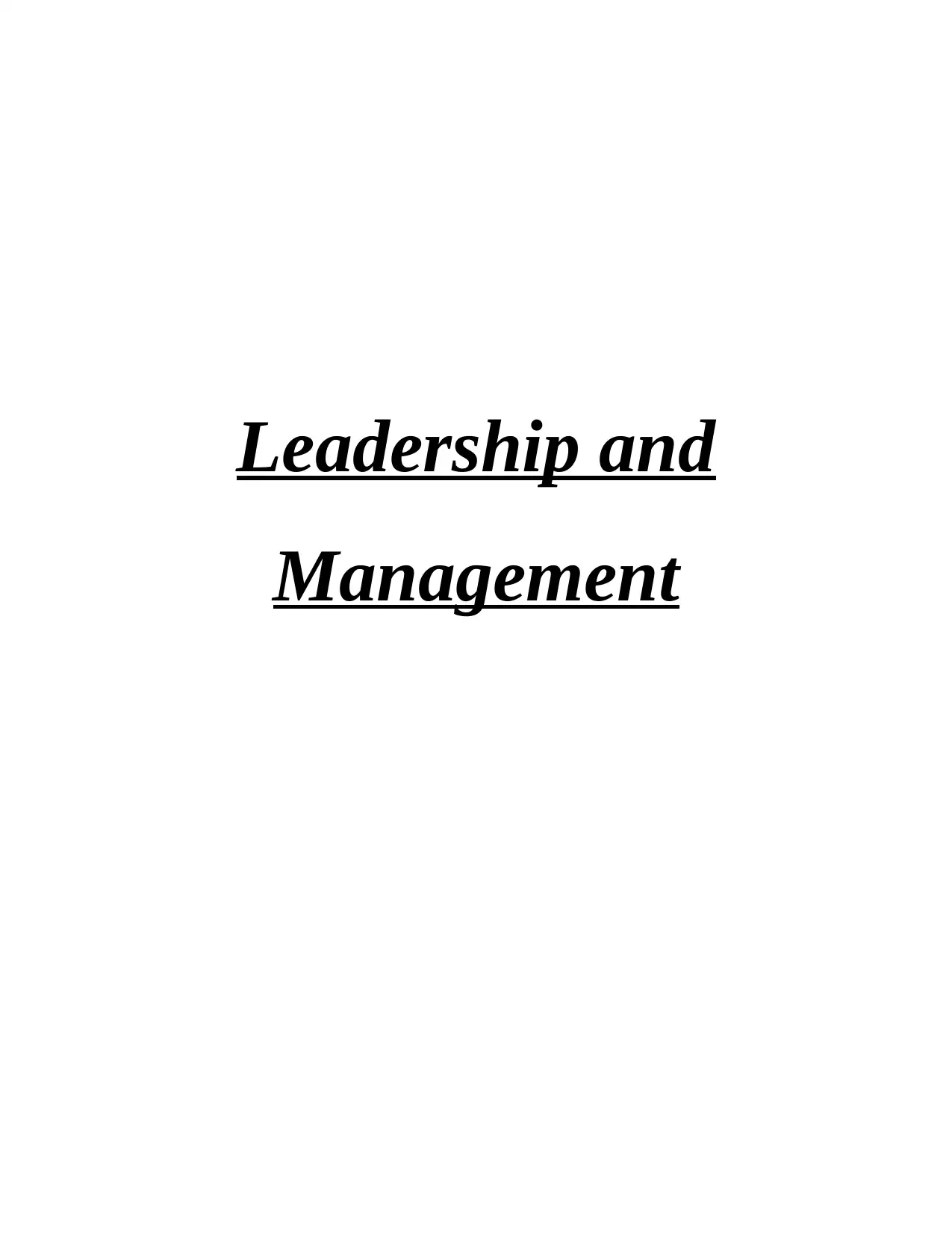
Leadership and
Management
Management
Paraphrase This Document
Need a fresh take? Get an instant paraphrase of this document with our AI Paraphraser
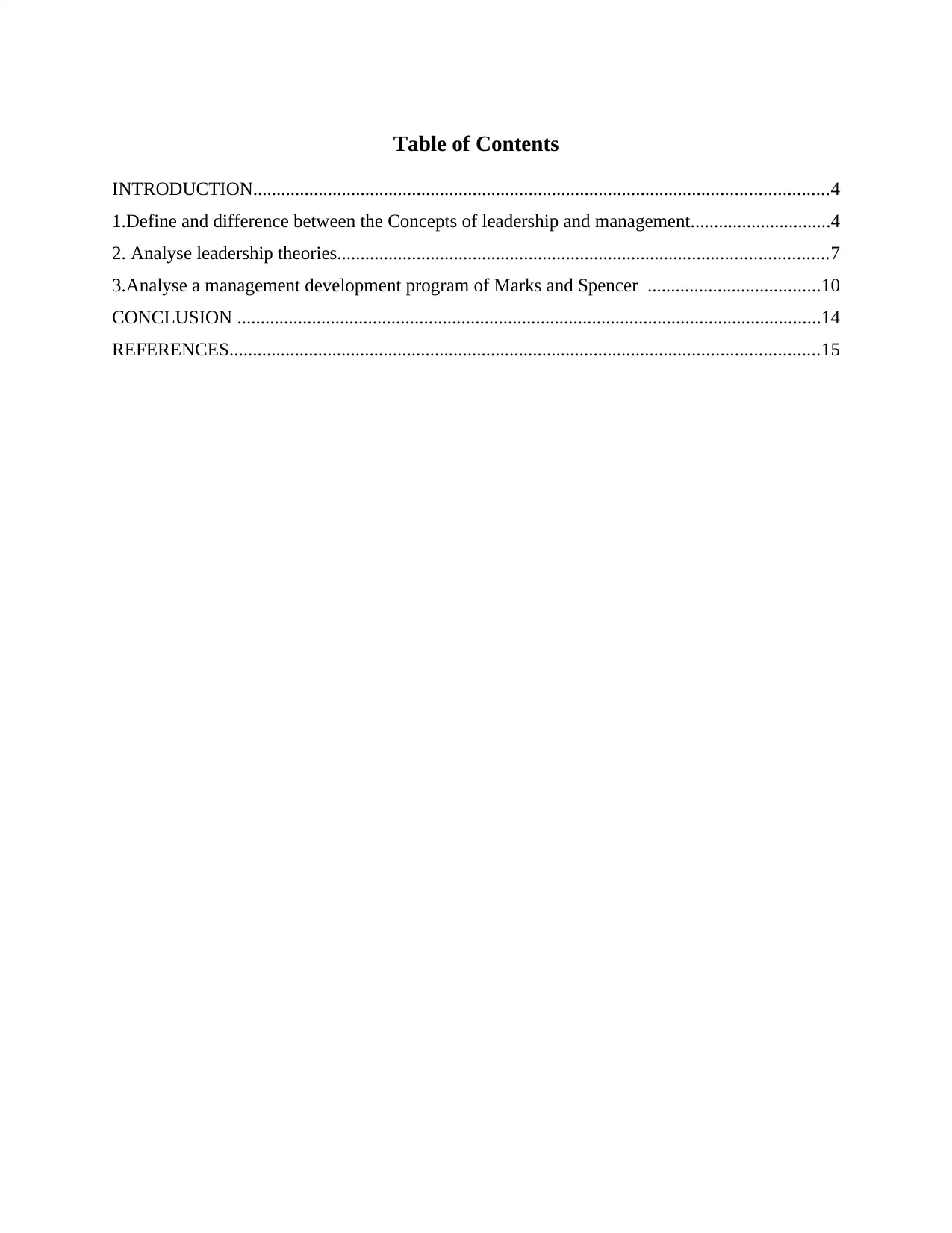
Table of Contents
INTRODUCTION...........................................................................................................................4
1.Define and difference between the Concepts of leadership and management..............................4
2. Analyse leadership theories.........................................................................................................7
3.Analyse a management development program of Marks and Spencer .....................................10
CONCLUSION .............................................................................................................................14
REFERENCES..............................................................................................................................15
INTRODUCTION...........................................................................................................................4
1.Define and difference between the Concepts of leadership and management..............................4
2. Analyse leadership theories.........................................................................................................7
3.Analyse a management development program of Marks and Spencer .....................................10
CONCLUSION .............................................................................................................................14
REFERENCES..............................................................................................................................15
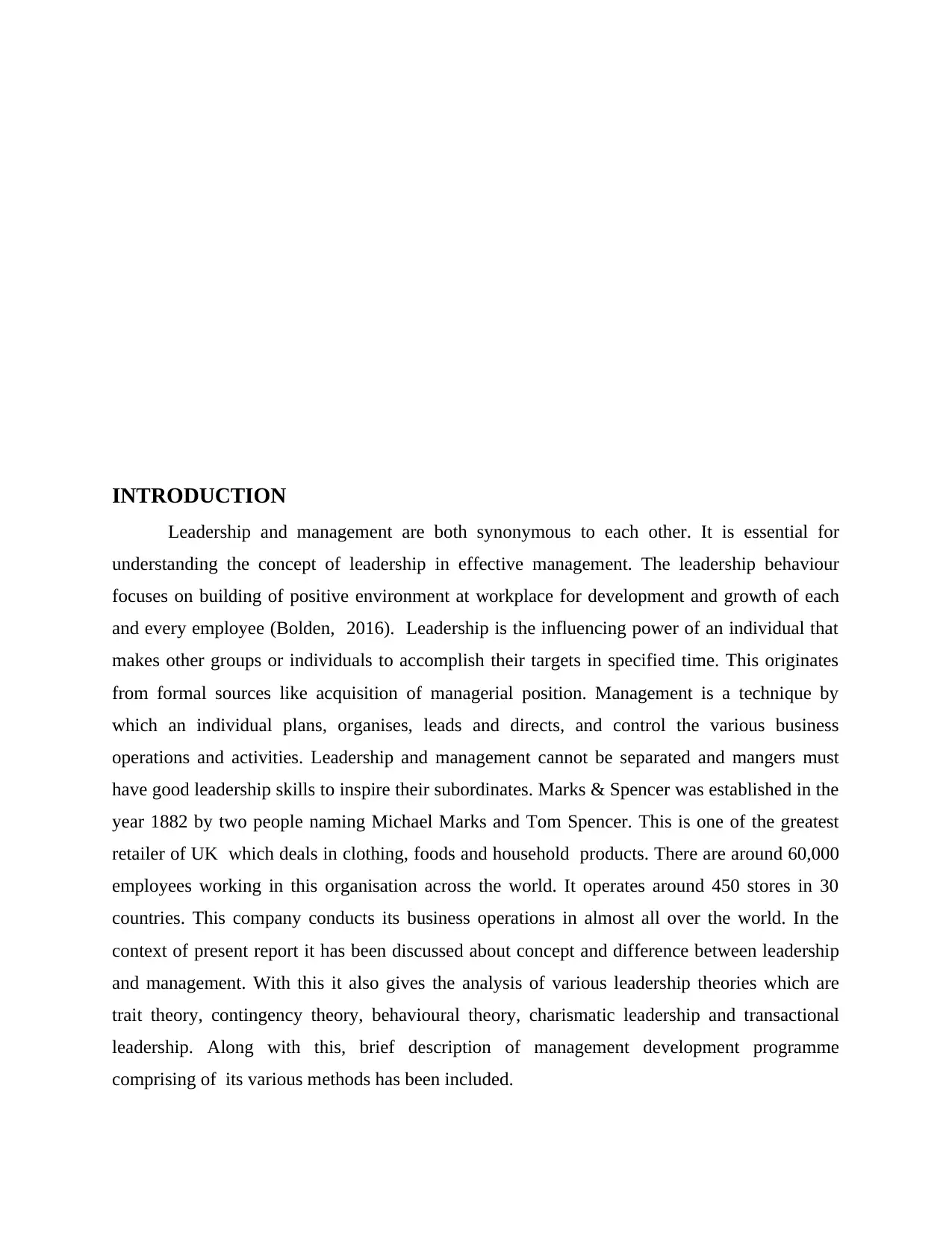
INTRODUCTION
Leadership and management are both synonymous to each other. It is essential for
understanding the concept of leadership in effective management. The leadership behaviour
focuses on building of positive environment at workplace for development and growth of each
and every employee (Bolden, 2016). Leadership is the influencing power of an individual that
makes other groups or individuals to accomplish their targets in specified time. This originates
from formal sources like acquisition of managerial position. Management is a technique by
which an individual plans, organises, leads and directs, and control the various business
operations and activities. Leadership and management cannot be separated and mangers must
have good leadership skills to inspire their subordinates. Marks & Spencer was established in the
year 1882 by two people naming Michael Marks and Tom Spencer. This is one of the greatest
retailer of UK which deals in clothing, foods and household products. There are around 60,000
employees working in this organisation across the world. It operates around 450 stores in 30
countries. This company conducts its business operations in almost all over the world. In the
context of present report it has been discussed about concept and difference between leadership
and management. With this it also gives the analysis of various leadership theories which are
trait theory, contingency theory, behavioural theory, charismatic leadership and transactional
leadership. Along with this, brief description of management development programme
comprising of its various methods has been included.
Leadership and management are both synonymous to each other. It is essential for
understanding the concept of leadership in effective management. The leadership behaviour
focuses on building of positive environment at workplace for development and growth of each
and every employee (Bolden, 2016). Leadership is the influencing power of an individual that
makes other groups or individuals to accomplish their targets in specified time. This originates
from formal sources like acquisition of managerial position. Management is a technique by
which an individual plans, organises, leads and directs, and control the various business
operations and activities. Leadership and management cannot be separated and mangers must
have good leadership skills to inspire their subordinates. Marks & Spencer was established in the
year 1882 by two people naming Michael Marks and Tom Spencer. This is one of the greatest
retailer of UK which deals in clothing, foods and household products. There are around 60,000
employees working in this organisation across the world. It operates around 450 stores in 30
countries. This company conducts its business operations in almost all over the world. In the
context of present report it has been discussed about concept and difference between leadership
and management. With this it also gives the analysis of various leadership theories which are
trait theory, contingency theory, behavioural theory, charismatic leadership and transactional
leadership. Along with this, brief description of management development programme
comprising of its various methods has been included.
⊘ This is a preview!⊘
Do you want full access?
Subscribe today to unlock all pages.

Trusted by 1+ million students worldwide
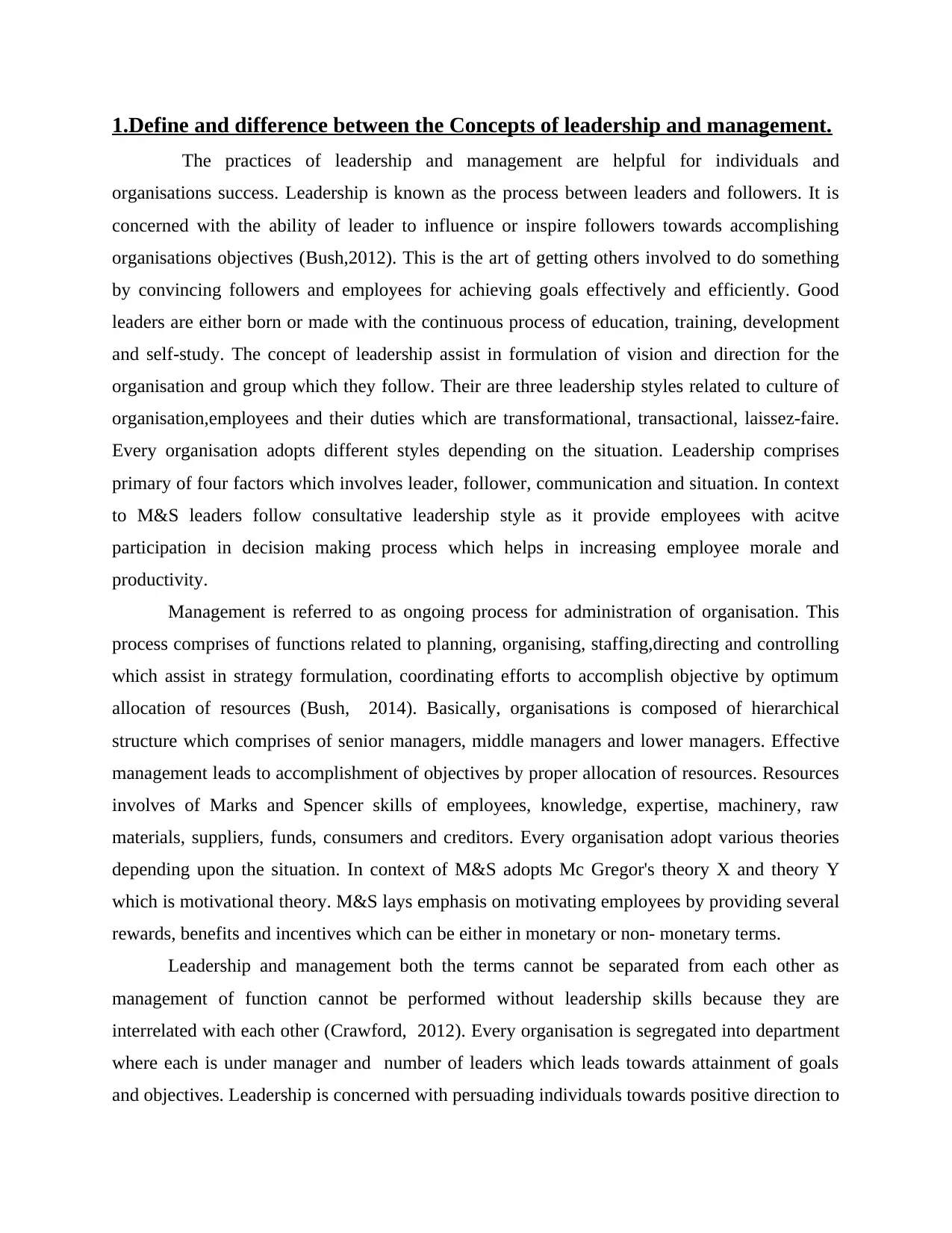
1.Define and difference between the Concepts of leadership and management.
The practices of leadership and management are helpful for individuals and
organisations success. Leadership is known as the process between leaders and followers. It is
concerned with the ability of leader to influence or inspire followers towards accomplishing
organisations objectives (Bush,2012). This is the art of getting others involved to do something
by convincing followers and employees for achieving goals effectively and efficiently. Good
leaders are either born or made with the continuous process of education, training, development
and self-study. The concept of leadership assist in formulation of vision and direction for the
organisation and group which they follow. Their are three leadership styles related to culture of
organisation,employees and their duties which are transformational, transactional, laissez-faire.
Every organisation adopts different styles depending on the situation. Leadership comprises
primary of four factors which involves leader, follower, communication and situation. In context
to M&S leaders follow consultative leadership style as it provide employees with acitve
participation in decision making process which helps in increasing employee morale and
productivity.
Management is referred to as ongoing process for administration of organisation. This
process comprises of functions related to planning, organising, staffing,directing and controlling
which assist in strategy formulation, coordinating efforts to accomplish objective by optimum
allocation of resources (Bush, 2014). Basically, organisations is composed of hierarchical
structure which comprises of senior managers, middle managers and lower managers. Effective
management leads to accomplishment of objectives by proper allocation of resources. Resources
involves of Marks and Spencer skills of employees, knowledge, expertise, machinery, raw
materials, suppliers, funds, consumers and creditors. Every organisation adopt various theories
depending upon the situation. In context of M&S adopts Mc Gregor's theory X and theory Y
which is motivational theory. M&S lays emphasis on motivating employees by providing several
rewards, benefits and incentives which can be either in monetary or non- monetary terms.
Leadership and management both the terms cannot be separated from each other as
management of function cannot be performed without leadership skills because they are
interrelated with each other (Crawford, 2012). Every organisation is segregated into department
where each is under manager and number of leaders which leads towards attainment of goals
and objectives. Leadership is concerned with persuading individuals towards positive direction to
The practices of leadership and management are helpful for individuals and
organisations success. Leadership is known as the process between leaders and followers. It is
concerned with the ability of leader to influence or inspire followers towards accomplishing
organisations objectives (Bush,2012). This is the art of getting others involved to do something
by convincing followers and employees for achieving goals effectively and efficiently. Good
leaders are either born or made with the continuous process of education, training, development
and self-study. The concept of leadership assist in formulation of vision and direction for the
organisation and group which they follow. Their are three leadership styles related to culture of
organisation,employees and their duties which are transformational, transactional, laissez-faire.
Every organisation adopts different styles depending on the situation. Leadership comprises
primary of four factors which involves leader, follower, communication and situation. In context
to M&S leaders follow consultative leadership style as it provide employees with acitve
participation in decision making process which helps in increasing employee morale and
productivity.
Management is referred to as ongoing process for administration of organisation. This
process comprises of functions related to planning, organising, staffing,directing and controlling
which assist in strategy formulation, coordinating efforts to accomplish objective by optimum
allocation of resources (Bush, 2014). Basically, organisations is composed of hierarchical
structure which comprises of senior managers, middle managers and lower managers. Effective
management leads to accomplishment of objectives by proper allocation of resources. Resources
involves of Marks and Spencer skills of employees, knowledge, expertise, machinery, raw
materials, suppliers, funds, consumers and creditors. Every organisation adopt various theories
depending upon the situation. In context of M&S adopts Mc Gregor's theory X and theory Y
which is motivational theory. M&S lays emphasis on motivating employees by providing several
rewards, benefits and incentives which can be either in monetary or non- monetary terms.
Leadership and management both the terms cannot be separated from each other as
management of function cannot be performed without leadership skills because they are
interrelated with each other (Crawford, 2012). Every organisation is segregated into department
where each is under manager and number of leaders which leads towards attainment of goals
and objectives. Leadership is concerned with persuading individuals towards positive direction to
Paraphrase This Document
Need a fresh take? Get an instant paraphrase of this document with our AI Paraphraser
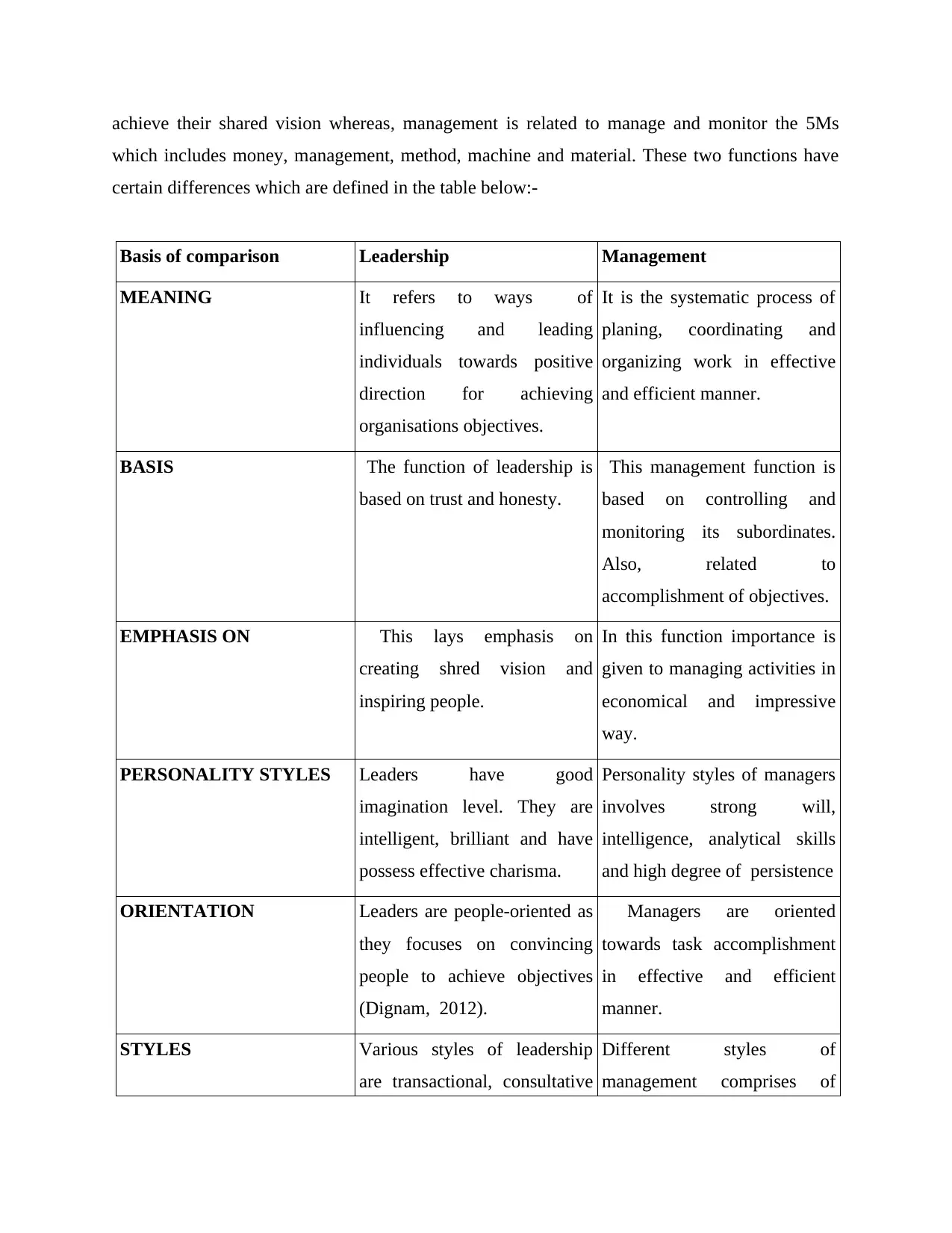
achieve their shared vision whereas, management is related to manage and monitor the 5Ms
which includes money, management, method, machine and material. These two functions have
certain differences which are defined in the table below:-
Basis of comparison Leadership Management
MEANING It refers to ways of
influencing and leading
individuals towards positive
direction for achieving
organisations objectives.
It is the systematic process of
planing, coordinating and
organizing work in effective
and efficient manner.
BASIS The function of leadership is
based on trust and honesty.
This management function is
based on controlling and
monitoring its subordinates.
Also, related to
accomplishment of objectives.
EMPHASIS ON This lays emphasis on
creating shred vision and
inspiring people.
In this function importance is
given to managing activities in
economical and impressive
way.
PERSONALITY STYLES Leaders have good
imagination level. They are
intelligent, brilliant and have
possess effective charisma.
Personality styles of managers
involves strong will,
intelligence, analytical skills
and high degree of persistence
ORIENTATION Leaders are people-oriented as
they focuses on convincing
people to achieve objectives
(Dignam, 2012).
Managers are oriented
towards task accomplishment
in effective and efficient
manner.
STYLES Various styles of leadership
are transactional, consultative
Different styles of
management comprises of
which includes money, management, method, machine and material. These two functions have
certain differences which are defined in the table below:-
Basis of comparison Leadership Management
MEANING It refers to ways of
influencing and leading
individuals towards positive
direction for achieving
organisations objectives.
It is the systematic process of
planing, coordinating and
organizing work in effective
and efficient manner.
BASIS The function of leadership is
based on trust and honesty.
This management function is
based on controlling and
monitoring its subordinates.
Also, related to
accomplishment of objectives.
EMPHASIS ON This lays emphasis on
creating shred vision and
inspiring people.
In this function importance is
given to managing activities in
economical and impressive
way.
PERSONALITY STYLES Leaders have good
imagination level. They are
intelligent, brilliant and have
possess effective charisma.
Personality styles of managers
involves strong will,
intelligence, analytical skills
and high degree of persistence
ORIENTATION Leaders are people-oriented as
they focuses on convincing
people to achieve objectives
(Dignam, 2012).
Managers are oriented
towards task accomplishment
in effective and efficient
manner.
STYLES Various styles of leadership
are transactional, consultative
Different styles of
management comprises of
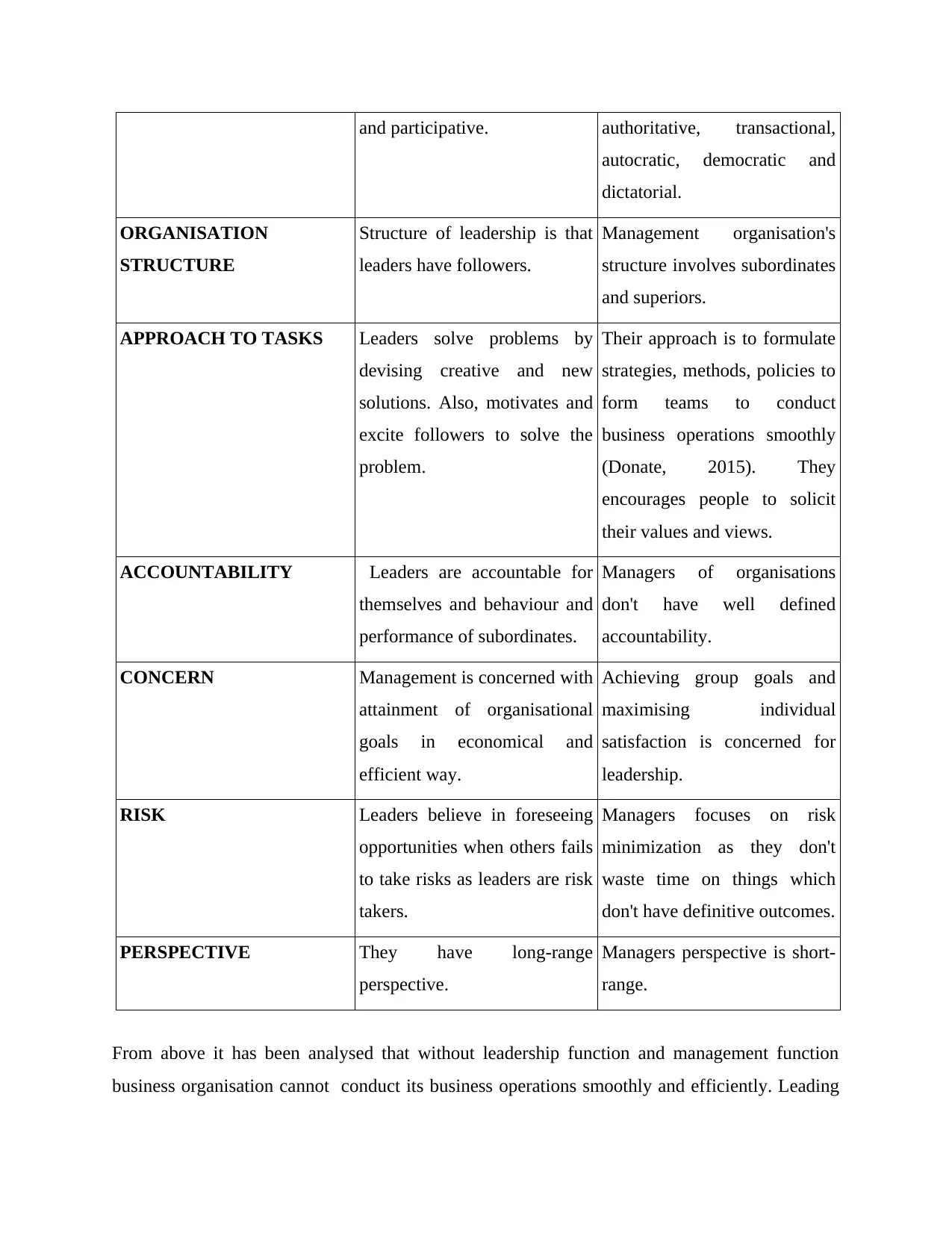
and participative. authoritative, transactional,
autocratic, democratic and
dictatorial.
ORGANISATION
STRUCTURE
Structure of leadership is that
leaders have followers.
Management organisation's
structure involves subordinates
and superiors.
APPROACH TO TASKS Leaders solve problems by
devising creative and new
solutions. Also, motivates and
excite followers to solve the
problem.
Their approach is to formulate
strategies, methods, policies to
form teams to conduct
business operations smoothly
(Donate, 2015). They
encourages people to solicit
their values and views.
ACCOUNTABILITY Leaders are accountable for
themselves and behaviour and
performance of subordinates.
Managers of organisations
don't have well defined
accountability.
CONCERN Management is concerned with
attainment of organisational
goals in economical and
efficient way.
Achieving group goals and
maximising individual
satisfaction is concerned for
leadership.
RISK Leaders believe in foreseeing
opportunities when others fails
to take risks as leaders are risk
takers.
Managers focuses on risk
minimization as they don't
waste time on things which
don't have definitive outcomes.
PERSPECTIVE They have long-range
perspective.
Managers perspective is short-
range.
From above it has been analysed that without leadership function and management function
business organisation cannot conduct its business operations smoothly and efficiently. Leading
autocratic, democratic and
dictatorial.
ORGANISATION
STRUCTURE
Structure of leadership is that
leaders have followers.
Management organisation's
structure involves subordinates
and superiors.
APPROACH TO TASKS Leaders solve problems by
devising creative and new
solutions. Also, motivates and
excite followers to solve the
problem.
Their approach is to formulate
strategies, methods, policies to
form teams to conduct
business operations smoothly
(Donate, 2015). They
encourages people to solicit
their values and views.
ACCOUNTABILITY Leaders are accountable for
themselves and behaviour and
performance of subordinates.
Managers of organisations
don't have well defined
accountability.
CONCERN Management is concerned with
attainment of organisational
goals in economical and
efficient way.
Achieving group goals and
maximising individual
satisfaction is concerned for
leadership.
RISK Leaders believe in foreseeing
opportunities when others fails
to take risks as leaders are risk
takers.
Managers focuses on risk
minimization as they don't
waste time on things which
don't have definitive outcomes.
PERSPECTIVE They have long-range
perspective.
Managers perspective is short-
range.
From above it has been analysed that without leadership function and management function
business organisation cannot conduct its business operations smoothly and efficiently. Leading
⊘ This is a preview!⊘
Do you want full access?
Subscribe today to unlock all pages.

Trusted by 1+ million students worldwide
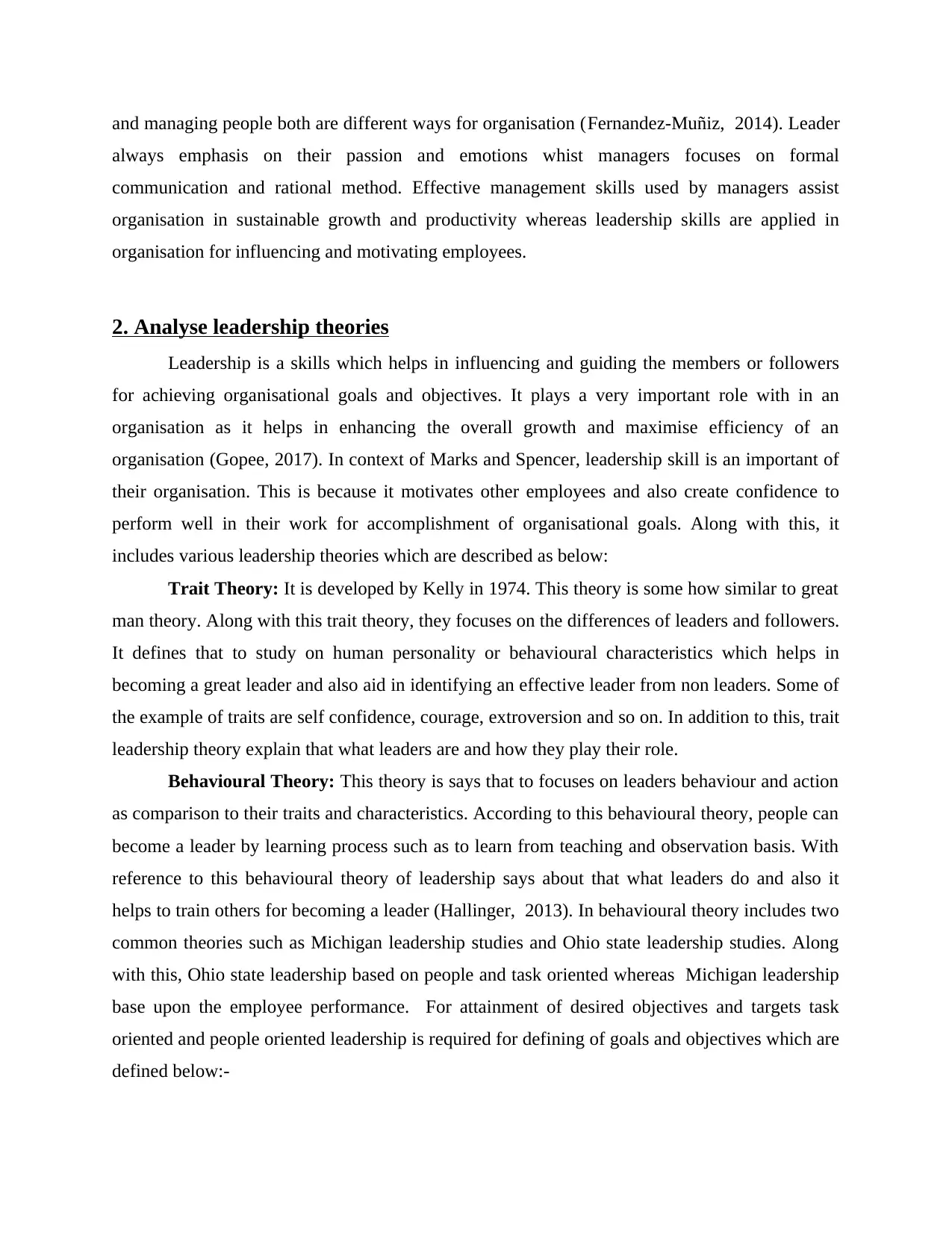
and managing people both are different ways for organisation (Fernandez-Muñiz, 2014). Leader
always emphasis on their passion and emotions whist managers focuses on formal
communication and rational method. Effective management skills used by managers assist
organisation in sustainable growth and productivity whereas leadership skills are applied in
organisation for influencing and motivating employees.
2. Analyse leadership theories
Leadership is a skills which helps in influencing and guiding the members or followers
for achieving organisational goals and objectives. It plays a very important role with in an
organisation as it helps in enhancing the overall growth and maximise efficiency of an
organisation (Gopee, 2017). In context of Marks and Spencer, leadership skill is an important of
their organisation. This is because it motivates other employees and also create confidence to
perform well in their work for accomplishment of organisational goals. Along with this, it
includes various leadership theories which are described as below:
Trait Theory: It is developed by Kelly in 1974. This theory is some how similar to great
man theory. Along with this trait theory, they focuses on the differences of leaders and followers.
It defines that to study on human personality or behavioural characteristics which helps in
becoming a great leader and also aid in identifying an effective leader from non leaders. Some of
the example of traits are self confidence, courage, extroversion and so on. In addition to this, trait
leadership theory explain that what leaders are and how they play their role.
Behavioural Theory: This theory is says that to focuses on leaders behaviour and action
as comparison to their traits and characteristics. According to this behavioural theory, people can
become a leader by learning process such as to learn from teaching and observation basis. With
reference to this behavioural theory of leadership says about that what leaders do and also it
helps to train others for becoming a leader (Hallinger, 2013). In behavioural theory includes two
common theories such as Michigan leadership studies and Ohio state leadership studies. Along
with this, Ohio state leadership based on people and task oriented whereas Michigan leadership
base upon the employee performance. For attainment of desired objectives and targets task
oriented and people oriented leadership is required for defining of goals and objectives which are
defined below:-
always emphasis on their passion and emotions whist managers focuses on formal
communication and rational method. Effective management skills used by managers assist
organisation in sustainable growth and productivity whereas leadership skills are applied in
organisation for influencing and motivating employees.
2. Analyse leadership theories
Leadership is a skills which helps in influencing and guiding the members or followers
for achieving organisational goals and objectives. It plays a very important role with in an
organisation as it helps in enhancing the overall growth and maximise efficiency of an
organisation (Gopee, 2017). In context of Marks and Spencer, leadership skill is an important of
their organisation. This is because it motivates other employees and also create confidence to
perform well in their work for accomplishment of organisational goals. Along with this, it
includes various leadership theories which are described as below:
Trait Theory: It is developed by Kelly in 1974. This theory is some how similar to great
man theory. Along with this trait theory, they focuses on the differences of leaders and followers.
It defines that to study on human personality or behavioural characteristics which helps in
becoming a great leader and also aid in identifying an effective leader from non leaders. Some of
the example of traits are self confidence, courage, extroversion and so on. In addition to this, trait
leadership theory explain that what leaders are and how they play their role.
Behavioural Theory: This theory is says that to focuses on leaders behaviour and action
as comparison to their traits and characteristics. According to this behavioural theory, people can
become a leader by learning process such as to learn from teaching and observation basis. With
reference to this behavioural theory of leadership says about that what leaders do and also it
helps to train others for becoming a leader (Hallinger, 2013). In behavioural theory includes two
common theories such as Michigan leadership studies and Ohio state leadership studies. Along
with this, Ohio state leadership based on people and task oriented whereas Michigan leadership
base upon the employee performance. For attainment of desired objectives and targets task
oriented and people oriented leadership is required for defining of goals and objectives which are
defined below:-
Paraphrase This Document
Need a fresh take? Get an instant paraphrase of this document with our AI Paraphraser
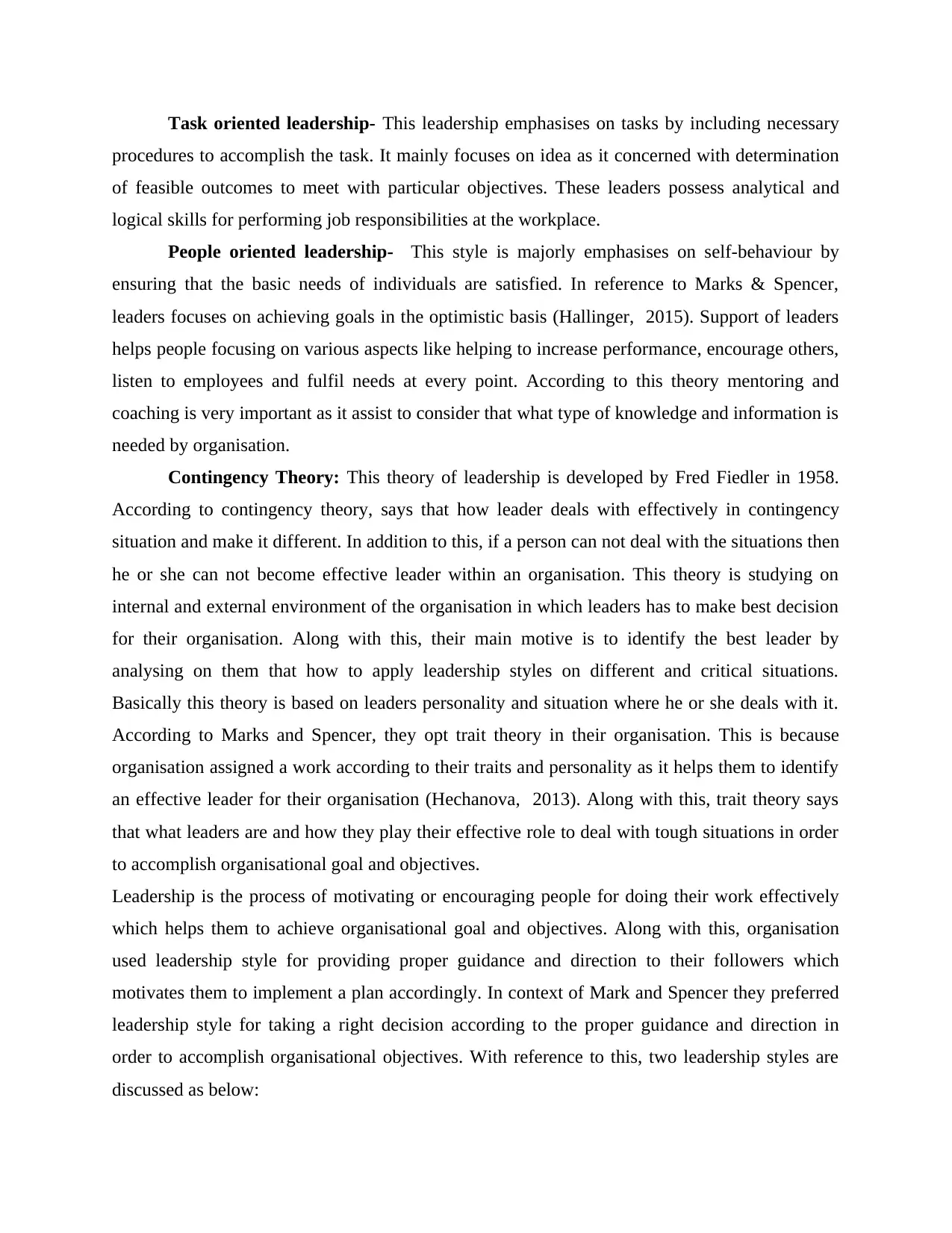
Task oriented leadership- This leadership emphasises on tasks by including necessary
procedures to accomplish the task. It mainly focuses on idea as it concerned with determination
of feasible outcomes to meet with particular objectives. These leaders possess analytical and
logical skills for performing job responsibilities at the workplace.
People oriented leadership- This style is majorly emphasises on self-behaviour by
ensuring that the basic needs of individuals are satisfied. In reference to Marks & Spencer,
leaders focuses on achieving goals in the optimistic basis (Hallinger, 2015). Support of leaders
helps people focusing on various aspects like helping to increase performance, encourage others,
listen to employees and fulfil needs at every point. According to this theory mentoring and
coaching is very important as it assist to consider that what type of knowledge and information is
needed by organisation.
Contingency Theory: This theory of leadership is developed by Fred Fiedler in 1958.
According to contingency theory, says that how leader deals with effectively in contingency
situation and make it different. In addition to this, if a person can not deal with the situations then
he or she can not become effective leader within an organisation. This theory is studying on
internal and external environment of the organisation in which leaders has to make best decision
for their organisation. Along with this, their main motive is to identify the best leader by
analysing on them that how to apply leadership styles on different and critical situations.
Basically this theory is based on leaders personality and situation where he or she deals with it.
According to Marks and Spencer, they opt trait theory in their organisation. This is because
organisation assigned a work according to their traits and personality as it helps them to identify
an effective leader for their organisation (Hechanova, 2013). Along with this, trait theory says
that what leaders are and how they play their effective role to deal with tough situations in order
to accomplish organisational goal and objectives.
Leadership is the process of motivating or encouraging people for doing their work effectively
which helps them to achieve organisational goal and objectives. Along with this, organisation
used leadership style for providing proper guidance and direction to their followers which
motivates them to implement a plan accordingly. In context of Mark and Spencer they preferred
leadership style for taking a right decision according to the proper guidance and direction in
order to accomplish organisational objectives. With reference to this, two leadership styles are
discussed as below:
procedures to accomplish the task. It mainly focuses on idea as it concerned with determination
of feasible outcomes to meet with particular objectives. These leaders possess analytical and
logical skills for performing job responsibilities at the workplace.
People oriented leadership- This style is majorly emphasises on self-behaviour by
ensuring that the basic needs of individuals are satisfied. In reference to Marks & Spencer,
leaders focuses on achieving goals in the optimistic basis (Hallinger, 2015). Support of leaders
helps people focusing on various aspects like helping to increase performance, encourage others,
listen to employees and fulfil needs at every point. According to this theory mentoring and
coaching is very important as it assist to consider that what type of knowledge and information is
needed by organisation.
Contingency Theory: This theory of leadership is developed by Fred Fiedler in 1958.
According to contingency theory, says that how leader deals with effectively in contingency
situation and make it different. In addition to this, if a person can not deal with the situations then
he or she can not become effective leader within an organisation. This theory is studying on
internal and external environment of the organisation in which leaders has to make best decision
for their organisation. Along with this, their main motive is to identify the best leader by
analysing on them that how to apply leadership styles on different and critical situations.
Basically this theory is based on leaders personality and situation where he or she deals with it.
According to Marks and Spencer, they opt trait theory in their organisation. This is because
organisation assigned a work according to their traits and personality as it helps them to identify
an effective leader for their organisation (Hechanova, 2013). Along with this, trait theory says
that what leaders are and how they play their effective role to deal with tough situations in order
to accomplish organisational goal and objectives.
Leadership is the process of motivating or encouraging people for doing their work effectively
which helps them to achieve organisational goal and objectives. Along with this, organisation
used leadership style for providing proper guidance and direction to their followers which
motivates them to implement a plan accordingly. In context of Mark and Spencer they preferred
leadership style for taking a right decision according to the proper guidance and direction in
order to accomplish organisational objectives. With reference to this, two leadership styles are
discussed as below:
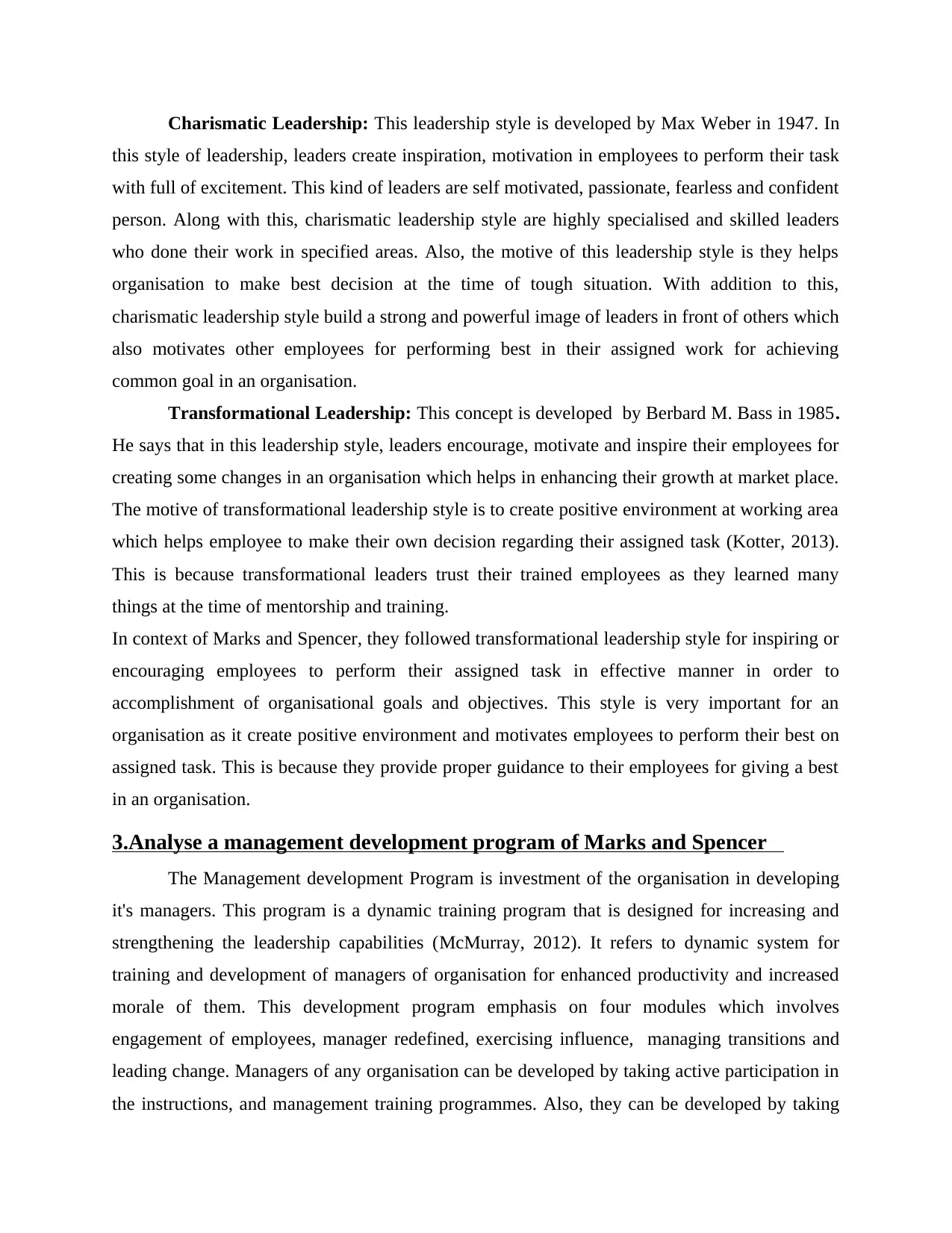
Charismatic Leadership: This leadership style is developed by Max Weber in 1947. In
this style of leadership, leaders create inspiration, motivation in employees to perform their task
with full of excitement. This kind of leaders are self motivated, passionate, fearless and confident
person. Along with this, charismatic leadership style are highly specialised and skilled leaders
who done their work in specified areas. Also, the motive of this leadership style is they helps
organisation to make best decision at the time of tough situation. With addition to this,
charismatic leadership style build a strong and powerful image of leaders in front of others which
also motivates other employees for performing best in their assigned work for achieving
common goal in an organisation.
Transformational Leadership: This concept is developed by Berbard M. Bass in 1985.
He says that in this leadership style, leaders encourage, motivate and inspire their employees for
creating some changes in an organisation which helps in enhancing their growth at market place.
The motive of transformational leadership style is to create positive environment at working area
which helps employee to make their own decision regarding their assigned task (Kotter, 2013).
This is because transformational leaders trust their trained employees as they learned many
things at the time of mentorship and training.
In context of Marks and Spencer, they followed transformational leadership style for inspiring or
encouraging employees to perform their assigned task in effective manner in order to
accomplishment of organisational goals and objectives. This style is very important for an
organisation as it create positive environment and motivates employees to perform their best on
assigned task. This is because they provide proper guidance to their employees for giving a best
in an organisation.
3.Analyse a management development program of Marks and Spencer
The Management development Program is investment of the organisation in developing
it's managers. This program is a dynamic training program that is designed for increasing and
strengthening the leadership capabilities (McMurray, 2012). It refers to dynamic system for
training and development of managers of organisation for enhanced productivity and increased
morale of them. This development program emphasis on four modules which involves
engagement of employees, manager redefined, exercising influence, managing transitions and
leading change. Managers of any organisation can be developed by taking active participation in
the instructions, and management training programmes. Also, they can be developed by taking
this style of leadership, leaders create inspiration, motivation in employees to perform their task
with full of excitement. This kind of leaders are self motivated, passionate, fearless and confident
person. Along with this, charismatic leadership style are highly specialised and skilled leaders
who done their work in specified areas. Also, the motive of this leadership style is they helps
organisation to make best decision at the time of tough situation. With addition to this,
charismatic leadership style build a strong and powerful image of leaders in front of others which
also motivates other employees for performing best in their assigned work for achieving
common goal in an organisation.
Transformational Leadership: This concept is developed by Berbard M. Bass in 1985.
He says that in this leadership style, leaders encourage, motivate and inspire their employees for
creating some changes in an organisation which helps in enhancing their growth at market place.
The motive of transformational leadership style is to create positive environment at working area
which helps employee to make their own decision regarding their assigned task (Kotter, 2013).
This is because transformational leaders trust their trained employees as they learned many
things at the time of mentorship and training.
In context of Marks and Spencer, they followed transformational leadership style for inspiring or
encouraging employees to perform their assigned task in effective manner in order to
accomplishment of organisational goals and objectives. This style is very important for an
organisation as it create positive environment and motivates employees to perform their best on
assigned task. This is because they provide proper guidance to their employees for giving a best
in an organisation.
3.Analyse a management development program of Marks and Spencer
The Management development Program is investment of the organisation in developing
it's managers. This program is a dynamic training program that is designed for increasing and
strengthening the leadership capabilities (McMurray, 2012). It refers to dynamic system for
training and development of managers of organisation for enhanced productivity and increased
morale of them. This development program emphasis on four modules which involves
engagement of employees, manager redefined, exercising influence, managing transitions and
leading change. Managers of any organisation can be developed by taking active participation in
the instructions, and management training programmes. Also, they can be developed by taking
⊘ This is a preview!⊘
Do you want full access?
Subscribe today to unlock all pages.

Trusted by 1+ million students worldwide
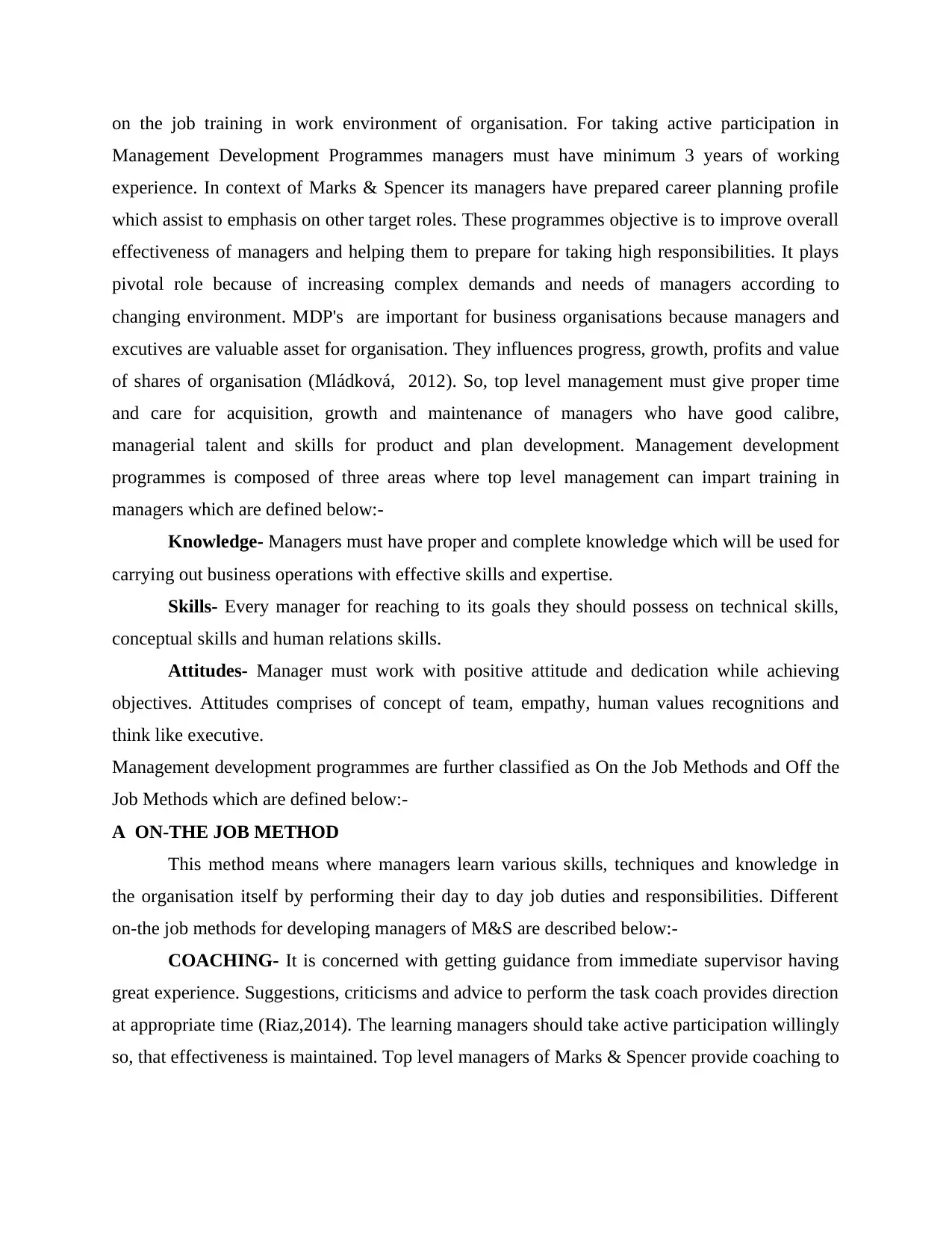
on the job training in work environment of organisation. For taking active participation in
Management Development Programmes managers must have minimum 3 years of working
experience. In context of Marks & Spencer its managers have prepared career planning profile
which assist to emphasis on other target roles. These programmes objective is to improve overall
effectiveness of managers and helping them to prepare for taking high responsibilities. It plays
pivotal role because of increasing complex demands and needs of managers according to
changing environment. MDP's are important for business organisations because managers and
excutives are valuable asset for organisation. They influences progress, growth, profits and value
of shares of organisation (Mládková, 2012). So, top level management must give proper time
and care for acquisition, growth and maintenance of managers who have good calibre,
managerial talent and skills for product and plan development. Management development
programmes is composed of three areas where top level management can impart training in
managers which are defined below:-
Knowledge- Managers must have proper and complete knowledge which will be used for
carrying out business operations with effective skills and expertise.
Skills- Every manager for reaching to its goals they should possess on technical skills,
conceptual skills and human relations skills.
Attitudes- Manager must work with positive attitude and dedication while achieving
objectives. Attitudes comprises of concept of team, empathy, human values recognitions and
think like executive.
Management development programmes are further classified as On the Job Methods and Off the
Job Methods which are defined below:-
A ON-THE JOB METHOD
This method means where managers learn various skills, techniques and knowledge in
the organisation itself by performing their day to day job duties and responsibilities. Different
on-the job methods for developing managers of M&S are described below:-
COACHING- It is concerned with getting guidance from immediate supervisor having
great experience. Suggestions, criticisms and advice to perform the task coach provides direction
at appropriate time (Riaz,2014). The learning managers should take active participation willingly
so, that effectiveness is maintained. Top level managers of Marks & Spencer provide coaching to
Management Development Programmes managers must have minimum 3 years of working
experience. In context of Marks & Spencer its managers have prepared career planning profile
which assist to emphasis on other target roles. These programmes objective is to improve overall
effectiveness of managers and helping them to prepare for taking high responsibilities. It plays
pivotal role because of increasing complex demands and needs of managers according to
changing environment. MDP's are important for business organisations because managers and
excutives are valuable asset for organisation. They influences progress, growth, profits and value
of shares of organisation (Mládková, 2012). So, top level management must give proper time
and care for acquisition, growth and maintenance of managers who have good calibre,
managerial talent and skills for product and plan development. Management development
programmes is composed of three areas where top level management can impart training in
managers which are defined below:-
Knowledge- Managers must have proper and complete knowledge which will be used for
carrying out business operations with effective skills and expertise.
Skills- Every manager for reaching to its goals they should possess on technical skills,
conceptual skills and human relations skills.
Attitudes- Manager must work with positive attitude and dedication while achieving
objectives. Attitudes comprises of concept of team, empathy, human values recognitions and
think like executive.
Management development programmes are further classified as On the Job Methods and Off the
Job Methods which are defined below:-
A ON-THE JOB METHOD
This method means where managers learn various skills, techniques and knowledge in
the organisation itself by performing their day to day job duties and responsibilities. Different
on-the job methods for developing managers of M&S are described below:-
COACHING- It is concerned with getting guidance from immediate supervisor having
great experience. Suggestions, criticisms and advice to perform the task coach provides direction
at appropriate time (Riaz,2014). The learning managers should take active participation willingly
so, that effectiveness is maintained. Top level managers of Marks & Spencer provide coaching to
Paraphrase This Document
Need a fresh take? Get an instant paraphrase of this document with our AI Paraphraser
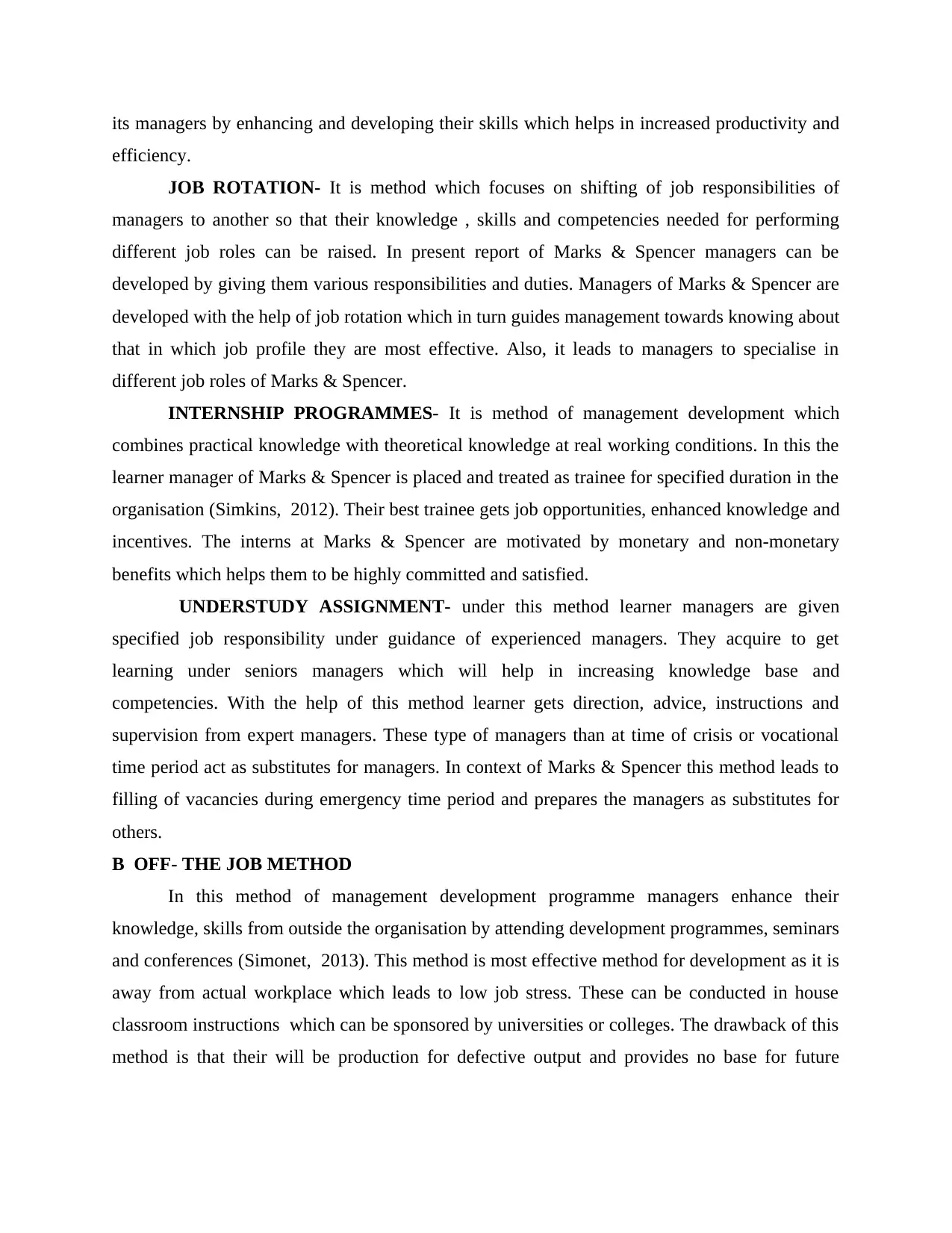
its managers by enhancing and developing their skills which helps in increased productivity and
efficiency.
JOB ROTATION- It is method which focuses on shifting of job responsibilities of
managers to another so that their knowledge , skills and competencies needed for performing
different job roles can be raised. In present report of Marks & Spencer managers can be
developed by giving them various responsibilities and duties. Managers of Marks & Spencer are
developed with the help of job rotation which in turn guides management towards knowing about
that in which job profile they are most effective. Also, it leads to managers to specialise in
different job roles of Marks & Spencer.
INTERNSHIP PROGRAMMES- It is method of management development which
combines practical knowledge with theoretical knowledge at real working conditions. In this the
learner manager of Marks & Spencer is placed and treated as trainee for specified duration in the
organisation (Simkins, 2012). Their best trainee gets job opportunities, enhanced knowledge and
incentives. The interns at Marks & Spencer are motivated by monetary and non-monetary
benefits which helps them to be highly committed and satisfied.
UNDERSTUDY ASSIGNMENT- under this method learner managers are given
specified job responsibility under guidance of experienced managers. They acquire to get
learning under seniors managers which will help in increasing knowledge base and
competencies. With the help of this method learner gets direction, advice, instructions and
supervision from expert managers. These type of managers than at time of crisis or vocational
time period act as substitutes for managers. In context of Marks & Spencer this method leads to
filling of vacancies during emergency time period and prepares the managers as substitutes for
others.
B OFF- THE JOB METHOD
In this method of management development programme managers enhance their
knowledge, skills from outside the organisation by attending development programmes, seminars
and conferences (Simonet, 2013). This method is most effective method for development as it is
away from actual workplace which leads to low job stress. These can be conducted in house
classroom instructions which can be sponsored by universities or colleges. The drawback of this
method is that their will be production for defective output and provides no base for future
efficiency.
JOB ROTATION- It is method which focuses on shifting of job responsibilities of
managers to another so that their knowledge , skills and competencies needed for performing
different job roles can be raised. In present report of Marks & Spencer managers can be
developed by giving them various responsibilities and duties. Managers of Marks & Spencer are
developed with the help of job rotation which in turn guides management towards knowing about
that in which job profile they are most effective. Also, it leads to managers to specialise in
different job roles of Marks & Spencer.
INTERNSHIP PROGRAMMES- It is method of management development which
combines practical knowledge with theoretical knowledge at real working conditions. In this the
learner manager of Marks & Spencer is placed and treated as trainee for specified duration in the
organisation (Simkins, 2012). Their best trainee gets job opportunities, enhanced knowledge and
incentives. The interns at Marks & Spencer are motivated by monetary and non-monetary
benefits which helps them to be highly committed and satisfied.
UNDERSTUDY ASSIGNMENT- under this method learner managers are given
specified job responsibility under guidance of experienced managers. They acquire to get
learning under seniors managers which will help in increasing knowledge base and
competencies. With the help of this method learner gets direction, advice, instructions and
supervision from expert managers. These type of managers than at time of crisis or vocational
time period act as substitutes for managers. In context of Marks & Spencer this method leads to
filling of vacancies during emergency time period and prepares the managers as substitutes for
others.
B OFF- THE JOB METHOD
In this method of management development programme managers enhance their
knowledge, skills from outside the organisation by attending development programmes, seminars
and conferences (Simonet, 2013). This method is most effective method for development as it is
away from actual workplace which leads to low job stress. These can be conducted in house
classroom instructions which can be sponsored by universities or colleges. The drawback of this
method is that their will be production for defective output and provides no base for future
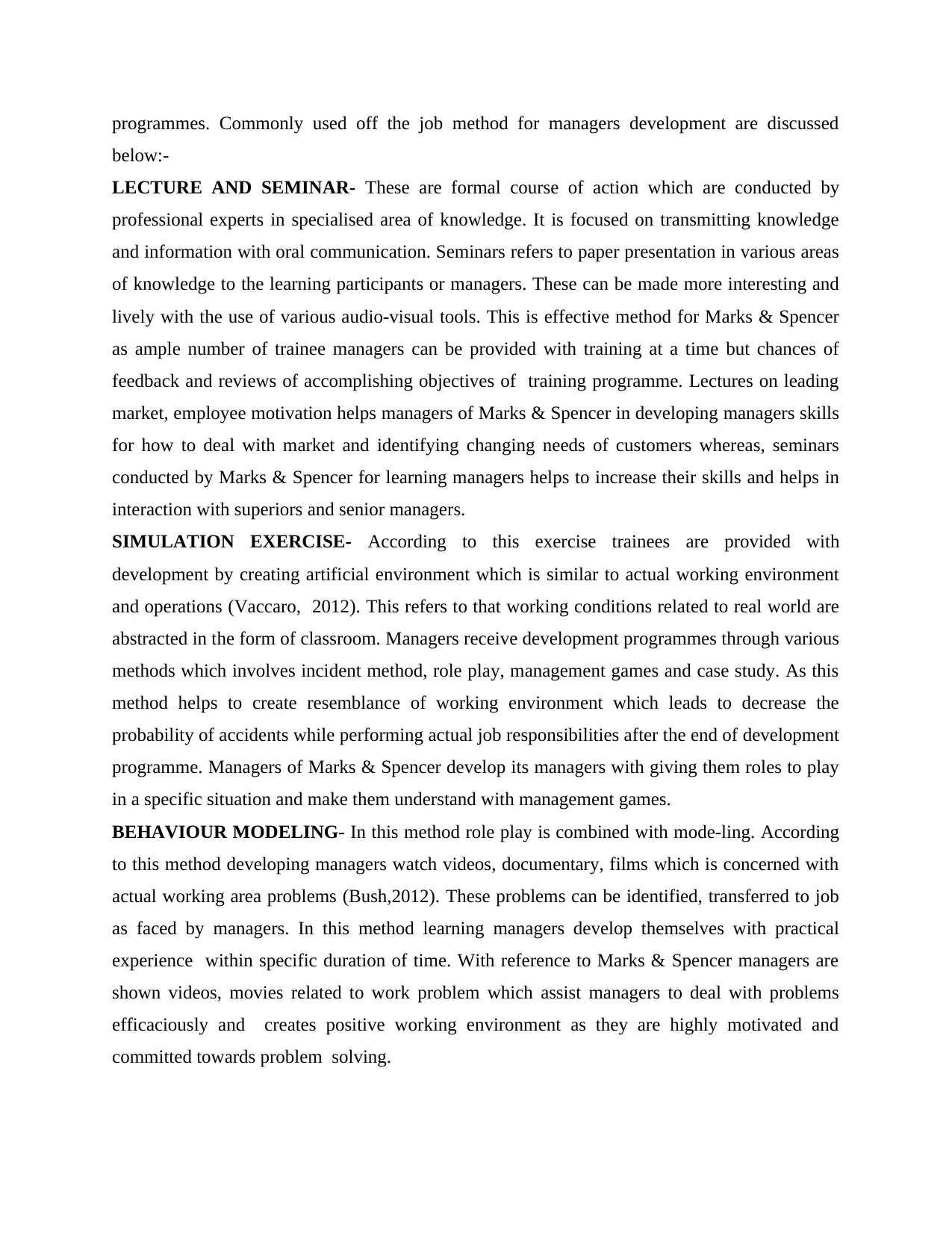
programmes. Commonly used off the job method for managers development are discussed
below:-
LECTURE AND SEMINAR- These are formal course of action which are conducted by
professional experts in specialised area of knowledge. It is focused on transmitting knowledge
and information with oral communication. Seminars refers to paper presentation in various areas
of knowledge to the learning participants or managers. These can be made more interesting and
lively with the use of various audio-visual tools. This is effective method for Marks & Spencer
as ample number of trainee managers can be provided with training at a time but chances of
feedback and reviews of accomplishing objectives of training programme. Lectures on leading
market, employee motivation helps managers of Marks & Spencer in developing managers skills
for how to deal with market and identifying changing needs of customers whereas, seminars
conducted by Marks & Spencer for learning managers helps to increase their skills and helps in
interaction with superiors and senior managers.
SIMULATION EXERCISE- According to this exercise trainees are provided with
development by creating artificial environment which is similar to actual working environment
and operations (Vaccaro, 2012). This refers to that working conditions related to real world are
abstracted in the form of classroom. Managers receive development programmes through various
methods which involves incident method, role play, management games and case study. As this
method helps to create resemblance of working environment which leads to decrease the
probability of accidents while performing actual job responsibilities after the end of development
programme. Managers of Marks & Spencer develop its managers with giving them roles to play
in a specific situation and make them understand with management games.
BEHAVIOUR MODELING- In this method role play is combined with mode-ling. According
to this method developing managers watch videos, documentary, films which is concerned with
actual working area problems (Bush,2012). These problems can be identified, transferred to job
as faced by managers. In this method learning managers develop themselves with practical
experience within specific duration of time. With reference to Marks & Spencer managers are
shown videos, movies related to work problem which assist managers to deal with problems
efficaciously and creates positive working environment as they are highly motivated and
committed towards problem solving.
below:-
LECTURE AND SEMINAR- These are formal course of action which are conducted by
professional experts in specialised area of knowledge. It is focused on transmitting knowledge
and information with oral communication. Seminars refers to paper presentation in various areas
of knowledge to the learning participants or managers. These can be made more interesting and
lively with the use of various audio-visual tools. This is effective method for Marks & Spencer
as ample number of trainee managers can be provided with training at a time but chances of
feedback and reviews of accomplishing objectives of training programme. Lectures on leading
market, employee motivation helps managers of Marks & Spencer in developing managers skills
for how to deal with market and identifying changing needs of customers whereas, seminars
conducted by Marks & Spencer for learning managers helps to increase their skills and helps in
interaction with superiors and senior managers.
SIMULATION EXERCISE- According to this exercise trainees are provided with
development by creating artificial environment which is similar to actual working environment
and operations (Vaccaro, 2012). This refers to that working conditions related to real world are
abstracted in the form of classroom. Managers receive development programmes through various
methods which involves incident method, role play, management games and case study. As this
method helps to create resemblance of working environment which leads to decrease the
probability of accidents while performing actual job responsibilities after the end of development
programme. Managers of Marks & Spencer develop its managers with giving them roles to play
in a specific situation and make them understand with management games.
BEHAVIOUR MODELING- In this method role play is combined with mode-ling. According
to this method developing managers watch videos, documentary, films which is concerned with
actual working area problems (Bush,2012). These problems can be identified, transferred to job
as faced by managers. In this method learning managers develop themselves with practical
experience within specific duration of time. With reference to Marks & Spencer managers are
shown videos, movies related to work problem which assist managers to deal with problems
efficaciously and creates positive working environment as they are highly motivated and
committed towards problem solving.
⊘ This is a preview!⊘
Do you want full access?
Subscribe today to unlock all pages.

Trusted by 1+ million students worldwide
1 out of 18
Related Documents
Your All-in-One AI-Powered Toolkit for Academic Success.
+13062052269
info@desklib.com
Available 24*7 on WhatsApp / Email
![[object Object]](/_next/static/media/star-bottom.7253800d.svg)
Unlock your academic potential
Copyright © 2020–2025 A2Z Services. All Rights Reserved. Developed and managed by ZUCOL.




